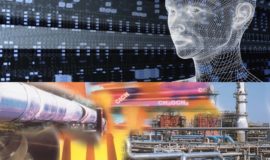
Artificial intelligence (AI) applications in process industries are a hot topic. But is it possible for the machines to completely replace the human resources? Because the brain is nonlinear and because it is so much larger than all current computers, it seems likely that will not happen in the near future.
Challenges of AI in Uncertain Processes
Generally, AI is more effective if you have your business in a stable world. If you deal with an uncertain process, with many variables in input and output parameters, then it becomes more difficult to establish definite patterns, that can be simulated and mathematically treated. The one assumption, which probably can be made is that it is better to include in mathematical models only the most important key performance indicators (KPI), which are directly related to the process efficiency. Even more important to verify that these KPI measurements are correct and consistent, by their validation prior to any mathematical exercises.
The starting point for choosing which KPIs are key to a particular process should be to be focused on those, that can characterize the given inputs against target outputs. There is a well-proven technology for setting network input and output parameters, input preprocessing settings, and output postprocessing settings, using weight initialization techniques to match input/target data.
The obvious way for this exercise in the downstream industry is to apply KPIs, which are directly related to the quality of process streams, i.e. physical properties and chemical composition of the incoming material and outgoing products in each process unit. This enables to establishment of a simplified process’ digital twin, which describes process objectives and includes in the decision tree only those KPIs, that are more relevant for the process efficiency. Additional KPIs to be considered are related to safety, security, and environmental requirements, which shall be applied as a constraint. This method enables overall process optimization through the integration of the network input and target KPIs, using linear programming techniques to maximize the overall profit.
Optimizing Refinery Performance
Efficient refinery optimization includes a complex of different components. Under proper operation conditions, each component will increase the process efficiency of the refinery. A major strategy in achieving the goal of running a refinery at the highest economic performance is to involve different technologies of hardware and software solutions. Hardware solutions are given by online process analyzers, which provide real-time quality monitoring of raw materials and products in process streams. Software solutions to increase the refinery’s financial performance include optimization software, dedicated to specific processing units, such as CDU, FCC, blending stations, etc.
The software calculates and predicts physical properties and chemical compositions for different refinery streams, and proposes required process set points, that will accomplish the calculated predictions. Process analyzers provide online analytic data, which is verified and validated against the laboratory results and predicted product quality. Integration of three technologies, feedstock characterization, thermodynamic simulation, and the analyzer feedback as an integrated package will afford a tool that allows the simulated digital twin to continuously be updated to allow the highest possible efficiency of the process at the lowest cost.
The reliability and accuracy of online process analyzers are extremely important when combining analytic data with predicting software, especially in the case of correlative analyzers, such as the NIR analyzer. The incorporation of model automatic correction software to prevent the drifting of analyzer results from laboratory data, and to verify full compliance between laboratory data and analyzer predicted values. This is of special interest during crude switching. Due to the gradient between two consecutive crudes, volumes and qualities of distillates change, and require to take immediate actions to minimize any impact on the process efficiency.
Economic refinery management requires a combination of different technologies, hardware as well and software that provides an entire overview of the operation of the refinery units based on quality data, as well as marketing, volume, supply of crude oils, energy, etc. Using the modern AI tools powered by accurate KPIs measurement, forms a basic tool from managers to operators to take the correct decisions to maintain and improve effective industrial processes management.






